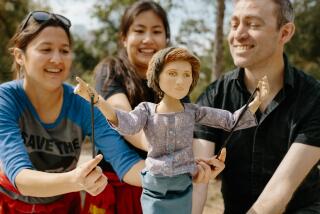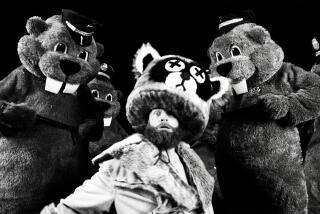Working Hollywood: Even puppets have their own stylists
The new film “The Beaver” stars Mel Gibson as a mentally ill man who begins to speak through a battered hand puppet that he retrieves from a dumpster in a moment of despair. Although the controversial star made a point to puppeteer the beaver himself, on the set, puppet wrangler Anney McKilligan Ozar was tasked with grooming the creature’s fur and even brushing its prominent teeth.
“I had to keep his teeth nice and shiny because things wear down,” she said.
On an average day on the job, McKilligan Ozar said she needs “everything from 18 different sizes of needles to 18 different sizes of drill bits.”
“I love the phrase ‘puppet wrangler’ because it makes people think of lassos and helicopters and wild animals, but it’s not really as glamorous as all that,” she said. “It’s maintaining and handling puppets. It’s basically a problem-solving job. You also have to be able to stitch and tie a knot in about 14 seconds. So you use your brain and your hands. And it’s a really good time because you’re playing with puppets.”
McKilligan Ozar always excelled at play. As a child in upstate New York, she did community theater with her mother.
“We were in a production of ‘Oliver!’ when I was 11,” she said. “She was the Widow Corney, and I was the well-fed orphan. And I always had very elaborate Halloween costumes and a huge stuffed animal collection. So that was evidence of what was to come of my life in puppets.”
In seventh grade, McKilligan Ozar made a 6-foot-tall giraffe Halloween costume out of cardboard tubes, chicken wire and fabric and wore it to school. Her love of performance led her to study acting at New York University’s Tisch School of the Arts, and she also enjoyed designing and making costumes.
During a production of the play “Infrared,” she met Janie Geiser, director of the Cotsen Center for Puppetry and the Arts at CalArts, and became her assistant. Geiser recommended McKilligan Ozar for her first big job as a puppet wrangler for the Broadway production of “The Lion King.”
Since then, McKilligan Ozar, who also goes by her artist name of Anney Fresh, has worked for the Public Theater and the Disney Channel, and she’s won three Daytime Emmys for her work on “Sesame Street.”
“Right now, we’re in the ‘Sesame’ season,” she said. “It’s always different, always ridiculous. Last week, I had to turn four different vegetables into drag queen backup singers. How do I make a male broccoli look like a female impersonator in the next hour? That’s what the fun is, being creative on the fly.”
Critter country: “There were six different beavers for the various needs of the production,” said McKilligan Ozar. “We had a hero puppet. In puppet land, that’s the main puppet we use, the performer’s favorite. In the beaver’s case, it was a clean puppet, because the first time you see the beaver, he’s in a dirty state. There’s also a beaver that had to get wet. There was a damaged puppet. We had a mechanical beaver, which I’m not sure we actually ended up using, but it had a mechanized arm. And we had a duplicate of the hero, because you want to be able to change puppets if something happens to the hero puppet.”
Sticky fingers: “I do a tremendous amount of gluing,” said McKilligan Ozar. “It really is one of my best skills. Barge Cement, which is a contact cement used in the shoe industry, is what all good puppets are made of. What’s wonderful about that is it can be heat released. So 10 years later, you can take the puppet apart if you need to replace parts of it. You use a hair dryer, and the seams pop apart. So that’s the holy grail of puppet building, the Barge Cement.”
The eyes have it: “The eyes are the windows to the soul,” said McKilligan Ozar. “The eyes direct focus to where the puppet’s going, who he’s relating to. A lot of puppeteer training is done with pingpong balls on the top of your hand, because it’s all about the eyes. They’re put on an elastic band, and it’ll go around your hand. You can make a mouth with your thumb, and you talk with your hand. And it’s keeping those pingpong balls in the right direction.”
‘N sync: “Lip sync is forming the words with your hands,” said McKilligan Ozar. “It’s basically opening your mouth when you’re saying something and keeping it closed when you’re not, which can be very tricky. Mel did a lot of speeches in the movie, and you have to practice these things because of all of the syllables. Lip sync is very important.”
No pain, no gain: “Mel learned that it’s not always very comfortable doing puppeteering,” said McKilligan Ozar. “It’s a very physically demanding skill. Also, he used his left hand, which was a choice for the production. So as a right-handed person, his left hand was weaker than his right hand. Sometimes I was just like, ‘You have to rest. If your hand physically cannot open, you just need to stop and take it off for a minute. You have got to take a break. You’ll get carpal tunnel.’ But we always say: If it doesn’t hurt, you’re not doing it right.”
More to Read
The biggest entertainment stories
Get our big stories about Hollywood, film, television, music, arts, culture and more right in your inbox as soon as they publish.
You may occasionally receive promotional content from the Los Angeles Times.






